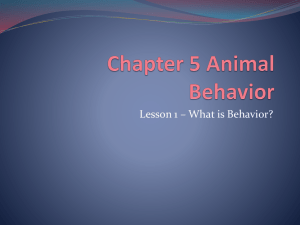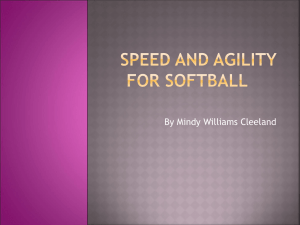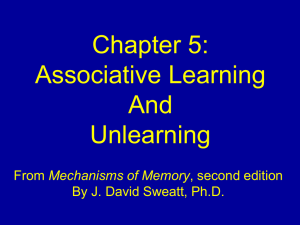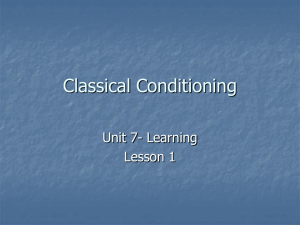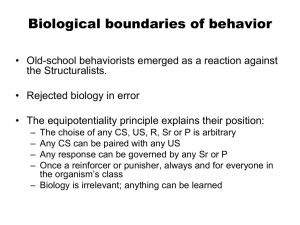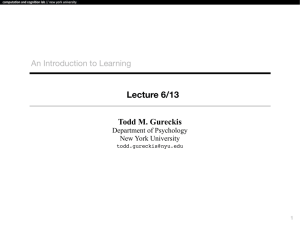Biology Cognition and Learning
advertisement
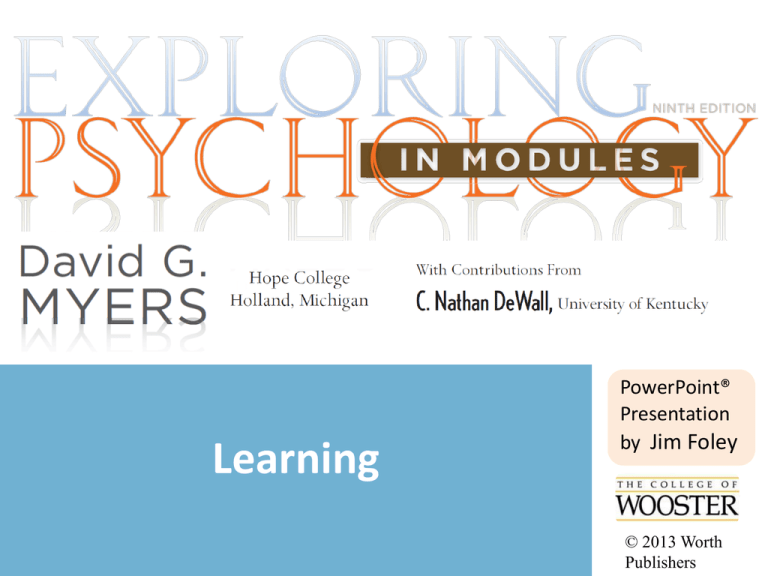
Learning PowerPoint® Presentation by Jim Foley © 2013 Worth Publishers Module 20: Biology, Cognition, and Learning Topics you can learn with the help of your body, thinking, and observation Biological constraints on conditioning Cognitive processes in conditioning Learning by Observation, including Mirroring and Imitation Prosocial and Antisocial Effects of Observational Learning Summary of factors affecting learning Biological Influences on Conditioning Classical Conditioning John Garcia and others found it was easier to learn associations that make sense for survival. Examples: Food aversions can be acquired even if the UR (nausea) does NOT immediately follow the NS. The body associates nausea with whatever food was recently eaten. Males in one study were more likely to see a pictured woman as attractive if the picture had a red border. Biological Constraints on Conditioning Operant Conditioning Can a monkey be trained to peck with its nose? No, but a pigeon can. Can a pigeon be trained to dive underwater? No, but a dolphin can. Operant conditioning encounters biological tendencies and limits that are difficult to override. What can we most easily train a dog to do based on natural tendencies? detecting scents? climbing and balancing? putting on clothes? Cognitive Processes in Conditioning In classical conditioning When the dog salivates at the bell, it may be due to cognition (learning to predict, even expect, the food). Knowing that our reactions such as food aversion are caused by conditioning gives us the option of mentally breaking the association. In operant conditioning In fixed-interval reinforcement, animals do more target behaviors/ responses around the time that the reward is more likely, as if expecting the reward. Expectation as a cognitive skill is even more evident in the ability of humans to respond to delayed reinforcers such as a paycheck. Latent Learning Rats appear to form cognitive maps. They can learn a maze just by wandering, with no cheese to reinforce their learning. Evidence of these maps is revealed once the cheese is placed somewhere in the maze. After only a few trials, these rats quickly catch up in mazesolving to rats who were rewarded with cheese all along. Latent learning refers to skills or knowledge gained from experience, but not apparent in behavior until rewards are given. Learning, Rewards, and Motivation Intrinsic motivation refers to the desire to perform a behavior well for its own sake. The reward is internalized as a feeling of satisfaction. Extrinsic motivation refers to doing a behavior to receive rewards from others. Intrinsic motivation can sometimes be reduced by external rewards, and can be prevented by using continuous reinforcement. One principle for maintaining behavior is to use as few rewards as possible, and fade the rewards over time. What might happen if we begin to reward a behavior someone was already doing and enjoying? Learning by Observation Can we, like the rats exploring the maze with no reward, learn new behaviors and skills without a direct experience of conditioning? Yes, and one of the ways we do so is by observational learning: watching what happens when other people do a behavior and learning from their experience. Skills required: mirroring, being able to picture ourselves doing the same action, and cognition, noticing consequences and associations. Observational Learning Processes The behavior of others serves as a model, an Modeling example of how to respond to a situation; we may try this model regardless of reinforcement. experienced indirectly, through others Vicarious Vicarious: Vicarious reinforcement and punishment means Conditioning our choices are affected as we see others get consequences for their behaviors. Albert Bandura’s Bobo Doll Experiment (1961) Kids saw adults punching an inflated doll while narrating their aggressive behaviors such as “kick him.” These kids were then put in a toy-deprived situation… and acted out the same behaviors they had seen. Mirroring in the Brain When we watch others doing or feeling something, neurons fire in patterns that would fire if we were doing the action or having the feeling ourselves. These neurons are referred to as mirror neurons, and they fire only to reflect the actions or feelings of others. From Mirroring to Imitation Humans are prone to spontaneous imitation of both behaviors and emotions (“emotional contagion”). This includes even overimitating, that is, copying adult behaviors that have no function and no reward. Children with autism are less likely to cognitively “mirror,” and less likely to follow someone else’s gaze as a neurotypical toddler (left) is doing below. Prosocial Effects of Observational Learning Prosocial behavior refers to actions which benefit others, contribute value to groups, and follow moral codes and social norms. Parents try to teach this behavior through lectures, but it may be taught best through modeling… especially if kids can see the benefits of the behavior to oneself or others. Antisocial Effects of Observational Learning What happens when we learn from models who demonstrate antisocial behavior, actions that are harmful to individuals and society? Children who witness violence in their homes, but are not physically harmed themselves, may hate violence but still may become violent more often than the average child. Perhaps this is a result of “the Bobo doll effect”? Under stress, we do what has been modeled for us. Media Models of Violence Do we learn antisocial behavior such as violence from indirect observations of others in the media? Research shows that viewing media violence leads to increased aggression (fights) and reduced prosocial behavior (such as helping an injured person). This violence-viewing effect might be explained by imitation, and also by desensitization toward pain in others. Epilogue: Learning about Learning From Pavlov and Watson to Skinner and Bandura, scientists have added to our understand of how we develop our associations, habits, our reactions and our patterns of behavior. Crucial to their success in learning how learning works: curiosity, and a willingness to study systematically , experimenting under controlled conditions, developing and testing ideas.
